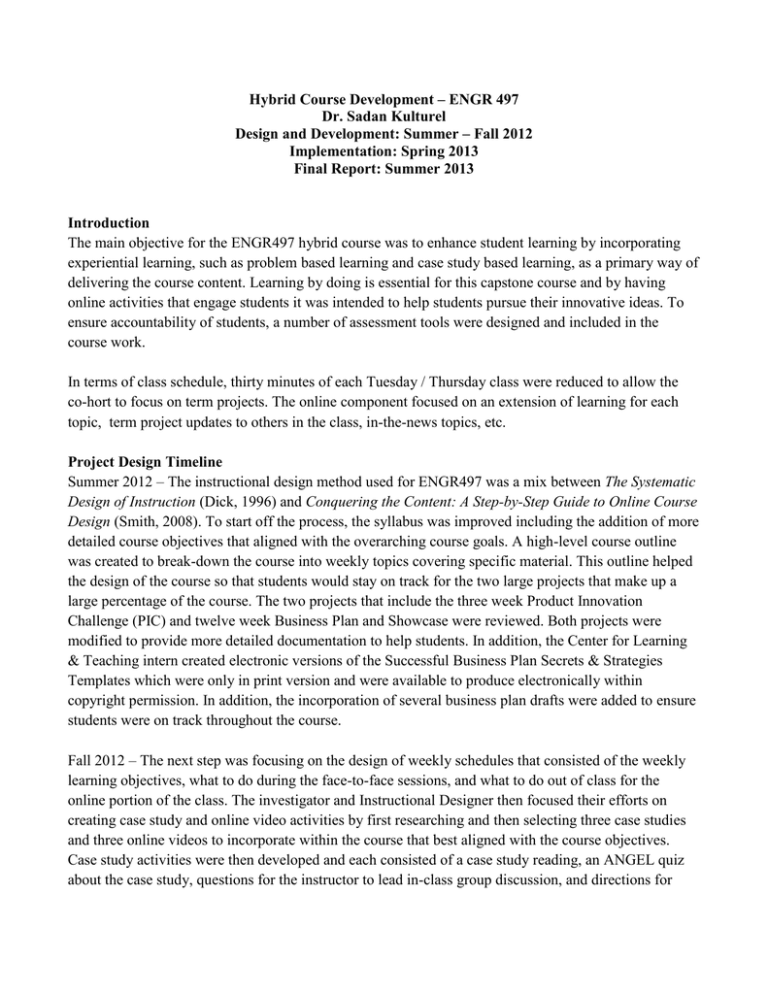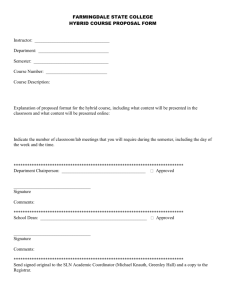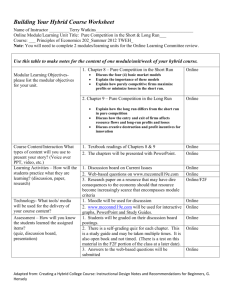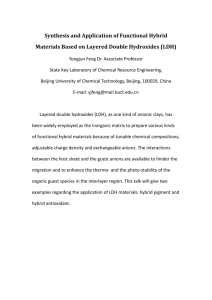ENGR 497 Engineering Special Topics
advertisement

Hybrid Course Development – ENGR 497 Dr. Sadan Kulturel Design and Development: Summer – Fall 2012 Implementation: Spring 2013 Final Report: Summer 2013 Introduction The main objective for the ENGR497 hybrid course was to enhance student learning by incorporating experiential learning, such as problem based learning and case study based learning, as a primary way of delivering the course content. Learning by doing is essential for this capstone course and by having online activities that engage students it was intended to help students pursue their innovative ideas. To ensure accountability of students, a number of assessment tools were designed and included in the course work. In terms of class schedule, thirty minutes of each Tuesday / Thursday class were reduced to allow the co-hort to focus on term projects. The online component focused on an extension of learning for each topic, term project updates to others in the class, in-the-news topics, etc. Project Design Timeline Summer 2012 – The instructional design method used for ENGR497 was a mix between The Systematic Design of Instruction (Dick, 1996) and Conquering the Content: A Step-by-Step Guide to Online Course Design (Smith, 2008). To start off the process, the syllabus was improved including the addition of more detailed course objectives that aligned with the overarching course goals. A high-level course outline was created to break-down the course into weekly topics covering specific material. This outline helped the design of the course so that students would stay on track for the two large projects that make up a large percentage of the course. The two projects that include the three week Product Innovation Challenge (PIC) and twelve week Business Plan and Showcase were reviewed. Both projects were modified to provide more detailed documentation to help students. In addition, the Center for Learning & Teaching intern created electronic versions of the Successful Business Plan Secrets & Strategies Templates which were only in print version and were available to produce electronically within copyright permission. In addition, the incorporation of several business plan drafts were added to ensure students were on track throughout the course. Fall 2012 – The next step was focusing on the design of weekly schedules that consisted of the weekly learning objectives, what to do during the face-to-face sessions, and what to do out of class for the online portion of the class. The investigator and Instructional Designer then focused their efforts on creating case study and online video activities by first researching and then selecting three case studies and three online videos to incorporate within the course that best aligned with the course objectives. Case study activities were then developed and each consisted of a case study reading, an ANGEL quiz about the case study, questions for the instructor to lead in-class group discussion, and directions for Dr. Sadan Kulturel 2 students for a written reflective paper after the in-class discussion. Video activities were also created and consisted of a video to watch, an ANGEL quiz about the video to ensure students watched the videos in its entirety, and a discussion board that helped relate the video to the course goals. A grading rubric was created to ensure proper student participation with the discussion board. During the Business Plan and Showcase portion of the course (weeks 4 through 15) students work to create a group business plan and presentation. While this is occurring each student posts the summary of the updates is to keep one another up to date about their progression. For the hybrid course, a workflow consisting of a blog update per group was established where, in turn, every student had to reply to at least one group that they did not belong to. To ensure this was implemented correctly during the spring 2013 semester, directions, a class blog, and a blog participation rubric were created. Once the weekly schedules were designed and the individual class activities were created, all of the components were put into the ANGEL Learning Management System. The components were arranged by weekly folder and within each folder a weekly schedule was developed using ANGEL pages and based upon the weekly schedules that were designed during the first portion of fall 2012. Spring 2013 – During the spring 2013 semester, the course was first implemented. After one-third of the course was conducted the investigator and Instructional Designer met and modified a mid-semester survey that the investigator used in previous courses. The modification focused on the addition of questions pertaining to the effectiveness of the components of the hybrid course and similar aspects. The mid-semester survey was then completed by students during week nine of the course. Learning Outcomes & Discussion Students were surveyed about a variety of topics at the midpoint of the semester. Focusing attention on the hybrid-format questions, Tables 1, 2, and 3 summarize the responses obtained (n=4) Table 1. Student satisfaction with hybrid component based assignments / course content Weekly Video Video Class within Discussion Response Guides in ANGEL are ANGEL are Boards are valuable. valuable. valuable. Strongly Agree Agree Neutral Somewhat Disagree Cases are valuable. ANGEL Case Quizzes are valuable. Business Plan Guidelines are valuable. Optional Electronic Business Plan Templates are valuable. 75% (3) 0% 0% 75% (3) 0% 50% (2) 25% (1) 25% (1) 0% 75% (3) 25% (1) 50% (2) 25% (1) 25% (1) 0% 25% (1) 75% (3) 50% (2) 0% 50% (2) 25% (1) 0% 0% 25% (1) 0% 0% 0% 0% Dr. Sadan Kulturel 3 Disagree Not Applicable 0% 0% 0% 0% 0% 0% 0% 0% 0% 0% 0% 0% 0% 0% As identified in Table 1, the majority of students found most of the online components of the hybrid course very favorable while the minority of students found them neutral and/or less favorable. The two items that were more neutral included the video discussion boards and the ANGEL Case Quizzes. The investigator contributes the neutral favorability of the online discussions to the very small group size this semester compared to other semesters. For future semesters, an alternative assignment will be conducted if class size is small to provide the best avenue for reflection on the videos. In regards to ANGEL Case Quizzes, questions may be altered in the future; however, the quizzes are needed to ensure students have read the material to engage in in-class discussion. Table 2. Student perception of active learning in the hybrid course format Response Always Very Often Often Occasionally Rarely or Never This course requires students to be active participants in the teaching and learning process. 75% (3) 0% 25% (1) 0% 0% As identified in Table 2, the majority of students (75%) found this course format required active learning as part of their course progression on a consistent basis. Quantitative data was not reviewed for this hybrid course to ensure the anonymity of students. Since the ENGR497 course has no more than 15 students, any type of quantitative analysis will not be conducted. Future Plans for Enhancement The design and development of a hybrid course is not a “once and done” procedure. The investigator will continue to evaluate the course after each semester and go through the reiterative process. This process is based upon the generic instructional systems design model called the ADDIE model that many hybrid / online course development models use as a basis today. The ADDIE model represents each phase including Analysis, Design, Development, Implementation, and Evaluation (Dick). In addition, the investigator will continue to work with the Instructional Designer as part of this process to strive for an improvement of learning and retention. Scholarly Outcomes There are currently no publications or presentations that resulted from this project. Dr. Sadan Kulturel 4 Recommendations Based on the experiences of designing and developing a hybrid course, the experiences of teaching a hybrid course, the findings of the qualitative data, and the students comments about their experiences in both the hybrid and traditional course sections, the investigator makes the following recommendations. 1. Flexibility: During the semester according to the student groups and what works best for them, the delivery style might be changed. 2. Duration: Start early in the design and development of hybrid courses since it takes longer than anticipated. 3. Clarification: Go over every single details, expectations and delivery format with students during the very first class. Conclusion The hybrid format of this course increased the level of active learning/participation from students. The students especially appreciated out of class time for this capstone course since they each worked on a different product innovation which needs specialized research. Acknowledgements The investigator gratefully acknowledges the help and support of the TLI team especially the Instructional Designer Amy Roche for her careful attention to each and every step and details and John Shank, Instructional Design Librarian and Director of the TLI for his suggestions while putting together the proposal for this project. The investigator also thanks to Dr. Paul Esqueda, Senior Associate Dean for Academic Affairs, for the opportunity to make the hybrid version of this course as part of our teaching improvement effort. Works Cited Dick, W. &. (1996). The Systematic Design of Instruction. New York: Harper Collins College Publishers. Smith, R. M. (2008). Conquering the Content: A Step-by-Step Guide to Online Course Design. San Francisco: Jossey-Bass.







